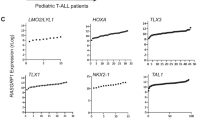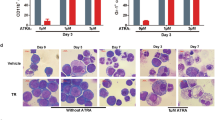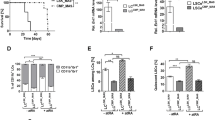Abstract
Alterations of the retinoic acid receptor (RAR)α locus are found in 100% of acute promyelocytic leukemia patients, where chromosomal translocations generate the promyelocytic leukemia (PML)-RARα chimeric protein. Here, we have investigated the biological properties of the other RAR isoforms (RARβ and RARγ), through the generation and characterization of artificial PML-RAR‘x’ fusion proteins. Surprisingly, we found that all of the RAR isoforms share an identical oncogenic potential in vitro, thus implying that the selection of the RARα locus in leukemia patients must occur – rather than through functional differences among the various RAR isoforms–as the consequence of the nuclear architecture of the different RAR loci.
This is a preview of subscription content, access via your institution
Access options
Subscribe to this journal
Receive 12 print issues and online access
$259.00 per year
only $21.58 per issue
Buy this article
- Purchase on Springer Link
- Instant access to full article PDF
Prices may be subject to local taxes which are calculated during checkout


Similar content being viewed by others
References
Melnick A, Licht JD . Deconstructing a disease: RAR a, its fusion partners, and their roles in the pathogenesis of acute promyelocytic leukemia. Blood 1999; 93: 3167–3215.
Minucci S, Pelicci PG . Histone deacetylase inhibitors and the promise of epigenetic (and more) treatments for cancer. Nat Rev Cancer 2006; 6: 38–51.
Lin RJ, Egan DA, Evans RM . Molecular genetics of acute promyelocytic leukemia. Trends Genet 1999; 15: 179–184.
Minucci S, Monestiroli S, Giavara S, Ronzoni S, Marchesi F et al. PML-RAR induces promyelocytic leukemias with high efficiency following retroviral gene transfer into purified murine hematopoietic progenitors. Blood 2002; 100: 2989–2995.
Chambon P . A decade of molecular biology of retinoic acid receptors. FASEB J 1996; 10: 940–954.
Mark M, Ghyselinck NB, Chambon P . Function of retinoid nuclear receptors: lessons from genetic and pharmacological dissections of the retinoic acid signaling pathway during mouse embryogenesis. Annu Rev Pharmacol Toxicol 2006; 46: 451–480.
Neves H, Ramos C, da Silva MG, Parreira A, Parreira L . The nuclear topography of ABL, BCR, PML, and RARα genes: evidence for gene proximity in specific phases of the cell cycle and stages of hematopoietic differentiation. Blood 1999; 93: 1197–1207.
Minucci S, Maccarana M, Cioce M, De Luca P, Gelmetti V et al. Oligomerization of RAR and AML1 transcription factors as a novel mechanism of oncogenic activation. Mol Cell 2000; 5: 811–820.
Carbone R, Botrugno OA, Ronzoni S, Insinga A, Di Croce L et al. Recruitment of the histone methyltransferase SUV39H1 and its role in the oncogenic properties of the leukemia-associated PML–retinoic acid receptor fusion protein. Mol Cell Biol 2006; 26: 1288–1296.
Di Croce L, Raker VA, Corsaro M, Fazi F, Fanelli M et al. Methyltransferase recruitment and DNA hypermethylation of target promoters by an oncogenic transcription factor. Science 2002; 295: 1079–1082.
Farboud B, Hauksdottir H, Wu Y, Privalsky ML . Isotype-restricted corepressor recruitment: a constitutively closed helix 12 conformation in retinoic acid receptors beta and gamma interferes with corepressor recruitment and prevents transcriptional repression. Mol Cell Biol 2003; 23: 2844–2858.
Hauksdottir H, Farboud B, Privalsky ML . Retinoic acid receptors beta and gamma do not repress, but instead activate target gene transcription in both the absence and presence of hormone ligand. Mol Endocrinol 2003; 17: 373–385.
Fanelli M, Minucci S, Gelmetti V, Nervi C, Gambacorti-Passerini C, Pelicci PG . Constitutive degradation of PML/RARα through the proteasome pathway mediates retinoic acid resistance. Blood 1999; 93: 1477–1481.
Sun SY, Lotan R . Retinoids and their receptors in cancer development and chemoprevention. Crit Rev Oncol Hematol 2002; 41: 41–55.
Yoshida H, Naoe T, Fukutani H, Kiyoi H, Kubo K, Ohno R . Analysis of the joining sequences of the t(15;17) translocation in human acute promyelocytic leukemia: sequence non-specific recombination between the PML and RARα genes within identical short stretches. Genes Chromosomes Cancer 1995; 12: 37–44.
Acknowledgements
This study has been supported by grants from MIUR (Cofin, FIRB), AIRC to SM.
Author information
Authors and Affiliations
Corresponding author
Rights and permissions
About this article
Cite this article
Marinelli, A., Bossi, D., Pelicci, P. et al. A redundant oncogenic potential of the retinoic receptor (RAR) α, β and γ isoforms in acute promyelocytic leukemia. Leukemia 21, 647–650 (2007). https://doi.org/10.1038/sj.leu.2404572
Received:
Revised:
Accepted:
Published:
Issue Date:
DOI: https://doi.org/10.1038/sj.leu.2404572
Keywords
This article is cited by
-
The genetics and clinical characteristics of children morphologically diagnosed as acute promyelocytic leukemia
Leukemia (2019)
-
Acute Promyelocytic Leukemia: A History over 60 Years—From the Most Malignant to the most Curable Form of Acute Leukemia
Oncology and Therapy (2019)
-
Identification of a novel CPSF6-RARG fusion transcript in acute myeloid leukemia resembling acute promyelocytic leukemia
Leukemia (2018)
-
Identification of a novel PML-RARG fusion in acute promyelocytic leukemia
Leukemia (2017)
-
Critical role of retinoid/rexinoid signaling in mediating transformation and therapeutic response of NUP98-RARG leukemia
Leukemia (2015)



